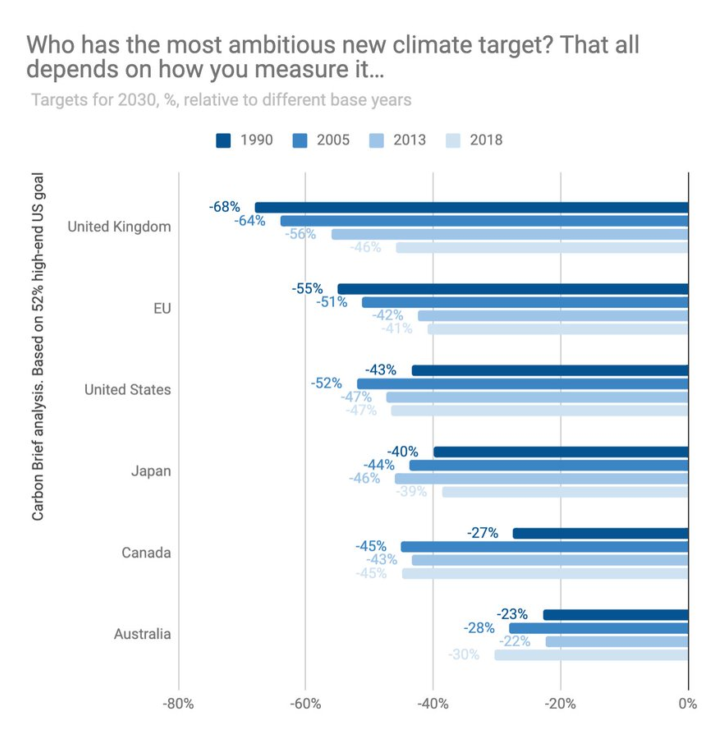Outcomes of the Leaders Summit on Climate
We distil what the major outcomes from Biden’s summit were and what this means for the UK.

By John Lang
Share
Last updated:
As the dust settles on the US-convened Leaders Summit on Climate, diplomatic attention turns to the UK-chaired G7 in June and the UK-hosted UN climate summit (COP26) in November.
- Back in the game: The US has begun the long road to rebuilding its climate credibility by presenting a new carbon-cutting pledge under the Paris Agreement. This includes a 50-52% emissions reduction from 2005 levels by 2030.
It's a major bump in ambition from Obama’s 2015 pledge of 26-28% from 2005 levels by 2025. The hard work starts now: getting on track to achieve that level of ambition will require much more near-term investment than even Biden’s $2.3tn infrastructure package. - Finance falls short: The US doubled its climate finance by 2024, including a tripling of adaptation funds from Obama-administration levels.
But the unofficial, and Congress-dependent,$5.7bn per year falls well short of the $800bn some campaigners suggest represents the US’s fair share of climate finance this decade.
In the lead up to Glasgow, UK Chancellor Rishi Sunak and COP president Alok Sharma have their work cut out to get fellow OECD finance ministers to stump up the $100bn per year promised by 2020. Maintaining the trust of poorer nations rests on it. - Other nations announced climate goals in the lead up to, and at the summit:
- The EU pledged a nationally determined contribution (NDC) emissions reduction of at least 55% below 1990 levels by 2030
- Canada pledged 40-45% below 2005 levels by 2030, at least a 10% upgrade on its previous pledge, but still graded by Climate Action Tracker as ‘insufficient’
- Japan pledged 46% below 2013 levels by 2030, a substantial advance on its previous target (a 26% reduction)
- South Korea will raise its NDC before COP and officially halt financing for foreign coal power projects.
- Meanwhile... the US and India announced a new climate partnership to ‘focus on driving urgent progress’ and Chinese President Xi Jinping, for the first time, announced China will start phasing out coal between 2026-2030
- Picking up the baton: The UK government and COP presidency is now expected to take the baton from the US. John Kerry’s diplomatic flurry before the Leaders Summit, including convincing China to acknowledge climate is a ‘crisis’, and turn up to the summit, shows what can be achieved.
COP president Alok Sharma has been engaged in diplomatic activity around the world already. But a COP President needs the support of senior colleagues and the wider government too. Prime Minister Boris Johnson, Foreign Secretary Dominic Raab, and Chancellor Rishi Sunak are expected to support Sharma to strike the myriad diplomatic deals to open the door to success at COP26. - Attention shifts to the G7: The main focus at the G7 in Cornwall in mid-June will be finance. The commitment from rich countries to provide $100bn per year to poorer countries for emissions cuts, climate adaptation, and loss and damage from climate impacts, was supposed to have been delivered by 2020.
Rich countries will be expected to deliver that now, ahead of COP, and begin the process of ramping up climate finance. Given that climate impact costs are now exacerbated in poorer nations by the crippling impact of Covid-19, the world is looking to G7 leaders to offer support for poorer nations in the form of debt relief, access to IMF funds via special drawing rights, and more innovative tools such as debt/climate swaps - whereby the cost of climate action is written off from existing debt obligations. - Public climate finance is currently a fraction of the trillions of dollars needed globally to deliver on the Paris Agreement. The Summit saw US Treasury Secretary Janet Yellen bring together leaders of private and multilateral development banks to underline the necessity of re-focusing global finance flows away from fossil fuels and towards climate solutions and a green pandemic recovery.
In fact, the day before the summit, the Glasgow Financial Alliance for Net-Zero was launched by UN and COP26 adviser Mark Carney and John Kerry, bringing 160 financial institutions managing $70 trillion of assets together to drive finance mobilisation. - Leveraging leadership: The UK’s NDC is widely regarded as world-leading already, and just before the US summit, the UK government accepted the UK Climate Change Committee’s sixth carbon budget advice - a 78% emissions reductions by 2035, committing the UK to a net zero by 2050-consistent pathway.
UK Ministers - particularly the Prime Minister, Foreign Secretary, and Chancellor - will want to leverage domestic climate leadership to enhance the credibility of their diplomatic efforts to persuade others to raise ambition. This will include providing a coherent, credible long-term strategy well before COP to demonstrate how the UK will deliver net zero by 2050. - The COP26 firing gun has been fired, but the UK Presidency will be expected to make the most of the Summit's impetus over the next six months. The UK, and other climate leaders - the US and the EU in particular - are still required to follow up new targets with real near-term action and long-term strategies to build momentum and show they deliver on promises.
It is up to the UK Presidency to frame a clear vision for what COP26 must achieve, and collaborate with other climate leaders on the diplomatic effort needed over the next six months to generate momentum up to the Glasgow summit, and beyond, into this decisive decade for climate action.

Share